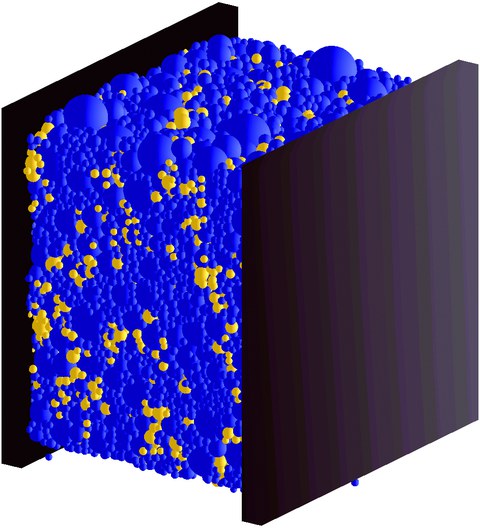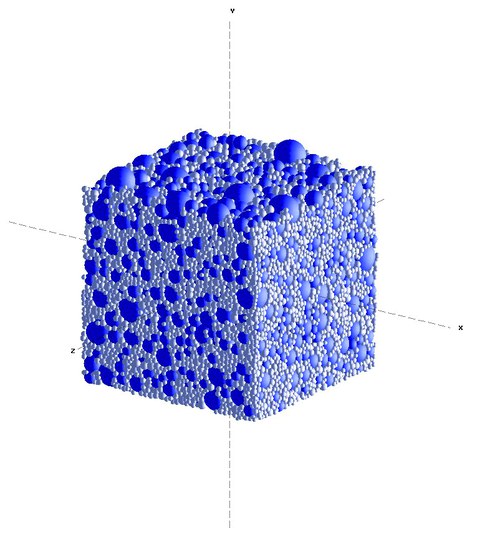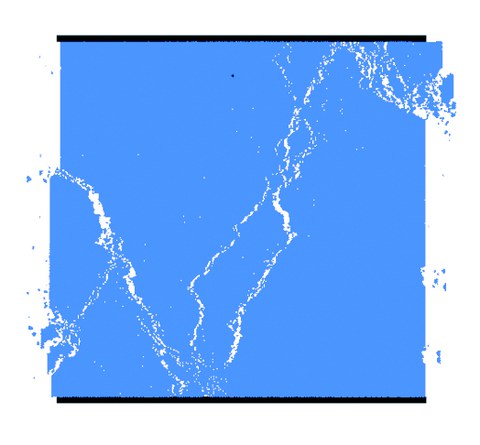DEM modeling the fracture behaviour of plain and reinforced concrete
Table of contents
Project data
|
Titel | Title |
Report in the yearbook 2011
Destructible, yet Indestructible: Virtual Specimens

A virtual specimen under pressure: Light-shaded particles have lost contact to one or more of their former contact partners, which may indicate crack propagation.
Experiments on the damage behaviour of concrete, especially on standardized, representative specimens, provide insight on the damage behaviour of the specimens used and – after having carried out a sufficient number of experiments – on the damage behavior of the material itself.
Experiments on the damage behaviour of real specimens, though, always imply destruction and non-reusability. The construction of representative, standardized test specimens is a non-trivial task and also the application of always the same loading scenarios in the testing machine requires considerable skill and care.
Virtual specimens are destructible and indestructible at the same time. The numerical simulation allows things that are impossible in reality: reusing the specimen in different load regimes, under different rates of loading, under another load application. Numerical experiments allow thus a replacing of the exact same “experiment” under changed conditions.
A prototype for cohesive frictional materials has been developed that will be gradually extended to gain better understanding of the basic failure mechanisms of concrete. The program allows the generation of heaps of spherical aggregate particles, the direct gluing of them (currently without the presence of a cement paste matrix) and finally the loading of the specimen by compression or tension. An interesting detail is seen in the layer-wise on-the-fly generation of aggregate particles above the virtual mould that allows the generation of extremely dense heaps of spherical particles, the particle size distribution is oriented towards realistic sieving curves. The resulting virtual specimens are stable in the unloaded state, behave elastically while the application of small loads and show clear damage behaviour with increasing compression or tension.
Due to our numerical simulations we hope to gain valuable insight into the failure mechanisms of concrete-like specimens, which may contribute to a better understanding of elastic and damage behaviour of the material as a whole.
Report in the yearbook 2010
Virtual Specimens: Looking Inside the Rock

Aggregates, oriented towards a realistic sieving distribution. Bigger particles are drawn blue, smaller ones gray. Many even much smaller particles are to represent the cementitious matrix, successively.
We have taken further steps towards achieving better understanding of concrete’s behaviour by means of numerical simulations. Virtual specimens – 2D, and now even 3D – undergo their first testing procedures, showing first and promising qualitative and quantitative results.
To give a short insight, the method is as easy as this: A specimen is seen as a conglomeration of small particles, each of them originating from a distinct distribution of size and material behaviour depending on whether it embodies cement or aggregate, taking in account concrete’s heterogeneous nature. The interaction of these particles according to Newton’s laws and a modern approach to include dissipation are the essentials of our computer implementation. The crucial point of our present work is finding a meso-structural contact model that sufficiently summarizes interactions of material on the molecular scale, letting computation feasible.
The model to be developed, however, is thought not only to reproduce experimental knowledge, it should give a feedback to our colleagues who carry out the tests.
Up to now, we are able to reproduce realistic crack patterns of virtual specimens in 2D computer simulations, accompanied by respective strain-stress relations. Moreover, progress has been made in the field of 3D simulations of crack propagation and material failure on a qualitative level. Our objective is to do on a computer screen what happened in the laboratory: 3D numerical simulations of the fatigue mechanisms of a concrete-like heterogeneous material consisting of an ensemble of differently-sized interacting particles. To be more ambitious, experience that can not be gained in the lab for practical reasons, we hope to be able to achieve by computer experiments in the near future.
Report in the yearbook 2009
Understanding Concrete Deeply: Trying to Do What Nature Does

Complete failure of a virtual specimen (50,000 particles) under pressure
Efforts are underway to develop a deeper understanding of concrete‘s behavior by means of numerical simulation. Virtual specimens undergo the same hard testing procedures as do their real-world experimental colleagues.
Briefly stated, this method takes into account the heterogeneous nature of concrete by viewing each virtual specimen as a conglomeration of small particles. Each particle originates from a distinct distribution of size and material behavior dependent on its embodiment – cement or aggregate. The interaction of these particles, according to Newton’s Laws and a modern approach that includes dissipation, are the essentials behind the computer simulations made.
With this goal in mind, an up-to-date particle-particle contact model is paired up with a simple, effective, and stable integration scheme designed to solve the equations of motion. Appropriate specification of material parameters is crucial for success in this area of research and can only be achieved when results of scientific computing are compared to real world situations to calibrate the underlying meso-structural model.
The model developed, however, must not only be limited to reproducing experimental knowledge, but it should also provide feedback for experimental work conducted. To date, realistic crack patterns have been reproduced in 2-D computer simulated (virtual) specimens that exhibit typical load-displacement relationships.
The objective is replicate what is done in the laboratory on a computer screen – 3-D numerical simulation of failure mechanisms of a heterogeneous, concrete-like material consisting of an assortment of various-sized, interacting particles. It is the hope that in the near future, experience that cannot otherwise be gained through laboratory experiments due to practical reasons, can be attained by implementing 3-D computer generated experiments.
